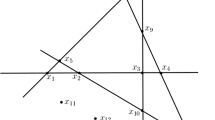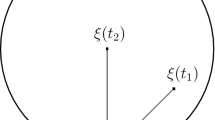Abstract
The paper initially investigates semi-topological properties of the Khalimsky (K-, for brevity) topological version of the classical Jordan curve theorem. Assume a simple closed K-curve with l elements in \(({\mathbb {Z}}^2, \kappa ^2)\) that is the K-topological plane, denoted by \(C_K^l\) for brevity. Then every \(C_K^l\) separates (\({\mathbb {Z}}^2, \kappa ^2)\) into exactly two nonempty components that may be neither open nor closed in (\({\mathbb {Z}}^2, \kappa ^2)\). Hence we need to investigate semi-topological features of \(C_K^l\) and \({\mathbb {Z}}^2 {\smallsetminus } C_K^l\) in \(({\mathbb {Z}}^2, \kappa ^2)\). We first show that not every \(C_K^l\) is always semi-open or semi-closed in \(({\mathbb {Z}}^2, \kappa ^2)\). Second, we find a condition for \(C_K^l\) to be either semi-open or semi-closed in \(({\mathbb {Z}}^2, \kappa ^2)\). After establishing a continuous analog of \(C_K^l\) denoted by \(\mathcal {A}(C_K^l)\,(\subset {\mathbb {R}}^2)\), we show that \(\mathcal {A}(C_K^l)\) is both semi-open and semi-closed in \(({\mathbb {R}}^2, \mathcal {U})\) that is the 2-dimensional real plane with the usual topology. Besides, we show that \(\mathcal {A}(C_K^l)\) always separates \(({\mathbb {R}}^2, \mathcal {U})\) into two non-empty components, denoted by C and D, that are both semi-open and semi-closed to obtain a partition of \({\mathbb {R}}^2\), i.e., \(\{C, D, \mathcal {A}(C_K^l)\}\). Finally, we obtain a partition of \({\mathbb {Z}}^2\), i.e., \(\{I(C_K^l), O(C_K^l), C_K^l\}\) and prove that each of \(I(C_K^l)\) and \(O(C_K^l)\) is semi-closed and it need not be semi-open, where \(I(C_K^l)\) and \(O(C_K^l)\) are called an inside and outside of \(C_K^l\), respectively.








Similar content being viewed by others
Data Availability Statement
The authors confirm that the data supporting the findings of this study are available within this article.
References
Alexandorff, P.: Uber die Metrisation der im Kleinen kompakten topologischen Räume. Math. Ann. 92(3–4), 294–301 (1924)
Alexandorff, P.: Diskrete Räume. Mat. Sb. 2, 501–518 (1937)
Crosseley, S.: A note on semitopological properties. Proc. AMS 72(2), 409–412 (1978)
Crosseley, S.G., Hildebrand, S.K.: Semi-closure. Texas J. Sci. 22, 99–112 (1971)
Han, S.-E.: Continuities and homeomorphisms in computer topology and their applications. J. Korean Math. Soc. 45, 923–952 (2008)
Han, S.-E.: A digitization method of subspaces of the Euclidean \(n\)D space associated with the Khalimsky adjacency structure. Comput. Appl. Math. 36, 127–144 (2017)
Han, S.-E.: Covering rough set structures for a locally finite covering approximation spaces. Inf. Sci. 480, 420–437 (2019)
Han, S.-E.: Jordan surface theorem for simple closed \(SST\)-surfaces. Topol. Appl. 272, 106953 (2020)
Han, S.-E.: Semi-separation axioms of the Khalimsky topological sphere. Topol. Appl. 275, 107006 (2020)
Han, S.-E.: Adjacency relations induced by some Alexandroff topologies on \({\mathbb{Z} }^n\). AIMS (Math.) 7(7), 11581–11596 (2022)
Han, S.-E., Özçağ, S.: The semi-\(T_3\)-separation axiom of Khalimsky topological spaces. Filomat 37(8), 2539–2559 (2023)
Han, S.-E., Sostak, A.: A compression of digital images derived from a Khalimsky topological structure. Comput. Appl. Math. 32, 521–536 (2013)
Khalimsky, E., Kopperman, R., Meyer, P.R.: Computer graphics and connected topologies on finite ordered sets. Topol. Appl. 36(1), 1–17 (1990)
Kiselman, C.O.: Digital Jordan curve theorem. LNCS 2000, 46–56 (1953)
Kong, T.Y., Rosenfeld, A.: Topological Algorithms for the Digital Image Processing. Elsevier Science, Amsterdam (1996)
Levine, N.: Semi-open sets and semi-continuity in topological spaces. Am. Math. Mon. 70, 36–41 (1963)
Munkres, J.R.: Topology A First Course. Prentice-Hall, Inc., Upper Saddle River (1975)
Nada, S.: Semi-open and semi-closed set in digital topological spaces. Commun. Fac. Sci. Univ. Ank. Ser. A1 53(1), 1–6 (2004)
Rosenfeld, A.: Connectivity in digital pictures. J. Assoc. Comput. Math. 17, 146–160 (1970)
Rosenfeld, A.: Arcs and curves in digital pictures. J. Assoc. Comput. Math. 20, 81–87 (1973)
Rosenfeld, A.: Adjacency in digital pictures. Inf. Control 26, 24–33 (1974)
Rosenfeld, A.: A converse to the Jordan curve theorem for digital curves. Inf. Control 29, 292–293 (1975)
Šlapal, J.: Digital Jordan curves. Topol. Appl. 153, 3255–3264 (2006)
Šlapal, J.: A quotient-universal digital topology. Theor. Comput. Sci. 405, 164–175 (2008)
Funding
The first author was supported by the Basic Science Research Program through the National Research Foundation of Korea (NRF) funded by the Ministry of Education, Science and Technology (2019R1I1A3A03059103). Besides, the first (resp. second) author was supported under the framework of an international cooperation program managed by the Korea-China (NRF-NSFC) joint research program (2021K2A9A2A06039864) (resp. National Natural Science Foundation of China, 12111540250).
Author information
Authors and Affiliations
Corresponding author
Ethics declarations
Conflict of interest
The authors declare no conflict of interest.
Additional information
Publisher's Note
Springer Nature remains neutral with regard to jurisdictional claims in published maps and institutional affiliations.
Rights and permissions
Springer Nature or its licensor (e.g. a society or other partner) holds exclusive rights to this article under a publishing agreement with the author(s) or other rightsholder(s); author self-archiving of the accepted manuscript version of this article is solely governed by the terms of such publishing agreement and applicable law.
About this article
Cite this article
Han, SE., Yao, W. Semi-topological Properties of the K-Topological Version of the Jordan Curve Theorem. Results Math 79, 7 (2024). https://doi.org/10.1007/s00025-023-02033-y
Received:
Accepted:
Published:
DOI: https://doi.org/10.1007/s00025-023-02033-y




